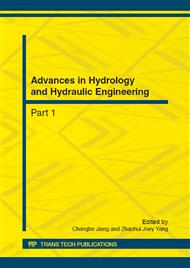p.554
p.560
p.564
p.569
p.574
p.578
p.586
p.593
p.600
Social Benefits on the Implementation of Integrated Water Allocation in the Yellow River
Abstract:
The situation in the 1990’s before the implementation of integrated water allocation in the Yellow River and the situation after the implementation between 1999 and 2008 are compared, and a combination of qualitative and quantitative analysis is adopted to assess the social effects of the ten year’s integrated water allocation in the Yellow River. The agricultural surface water consumption after the water regulation averagely decreased 17.7*108m3, and the eco-environmental water in the lower reaches during the non-flood season increased 14.6*108m3,which curbed the decreasing trend of ecological water use for the channel from the 1970s to1990s.The results show that the integrated water allocation in the Yellow River has established a comparatively fair order for water use, guaranteed the water supply safety and the national food safety.
Info:
Periodical:
Pages:
574-577
Citation:
Online since:
October 2012
Authors:
Price:
Сopyright:
© 2012 Trans Tech Publications Ltd. All Rights Reserved
Share:
Citation:


